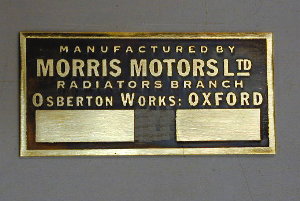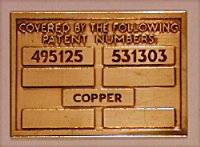
Ryder was the general manager of Coventry Radiators, a division of Doherty Motor Components. William R. Morris had been buying radiators from DMC, since the 1913 Morris Oxford, however DMC was not able to keep up with demand. WRM encouraged Ryder along with Davies to move to Oxford to start the business. There is some suggestion Morris was financially involved behind the scenes in the set up of the new venture.
In January of 1923, Osberton Radiators came under the sole ownership of WRM and Ryder was appointed as a Morris Motors director in addition to his duties as the General Manager of Osberton Radiators.
Later in 1923 Osberton Radiators moved from Osberton Road to a new factory on the Woodstock road. From 1925 to 1927, Cecil Kimber had space allocated to him for the production of MGs at the Bainton Road entrance to this new factory. In June of 1926 Osberton Radiators became Morris Radiators Branch. MG production was moved to Cowley in Sept. 1927.
On the TA and TB cars and early TC’s, a brass plate is usually found on the LH topside of the header tank in the crook of the "L" shaped pressing. On the later TC’s, this plate is generally found on the RH topside of the header tank aft of the "round" shaped pressing. The plates were hand numbered and attached to the header tank resulting in some variation in placement of both plates and numbers.

Originally, these plates were probably painted over with radiator black. These have been polished up nicely on present day cars.
There are two fields of numbers. The LH one suggests a job number or purchase order number and the RH set appear to be a sequence or serial number in ascending order within the P.O. number. Interestingly enough, this same plate is found on top of the fuel tanks in the "Y" series cars as the Osberton works made all sorts of tanks for the growing Morris organization.
The LH field of numbers and their associated dates are: 11650-1945 (possibly remaining stocks of TB radiators). 24616-early 1946 to late 1946. 31838-late 1946 to late 1947. 32719-late 1947 to early 1948. 33326- early 1948 to early 1949. 34973-early 1949 to mid 1949. 37198-mid 1949 to Nov. 1949, end of TC production. This last number shows up on a few earlier cars possibly this was a "factory replacement" scheme.
Another brass plate can be found on the radiator core itself located towards the top RH side facing the engine.

The dates of the patents are 1938 for the LH number and 1941 for the RH number. There are two sets of 4 digit numbers below the word "COPPER." The LH numbers appear to be the number of weeks followed by the year. I.E. 2247 is the twenty-second week of 1947. The RH number is the serial number of the core in ascending order. Copper is the core material and the header and lower tanks are made of brass.
The radiators were evidently brought into Abingdon in batches and not strictly used in "first-in, first-out" order. Very similar to the engines, bodies and chassis numbers this "pooling" effect is described in detail in the "TC’s Forever" book by Michael Sherrel.
Many replacement radiators have been installed in TC’s over the years. Some of the firms that attached plates to their replacement work are, "Serck Radiators, Ltd." "Victory Radiator works," and "Commercial Radiators, Ltd." Determining logical order to components of TC cars is full of pitfalls. There seems to as many numbering systems as there are parts. I have made assumptions based on the sample numbers I have been able to gather and I leave it to others to verify or disprove this work.
Ben Cordsen, Nov. 2001